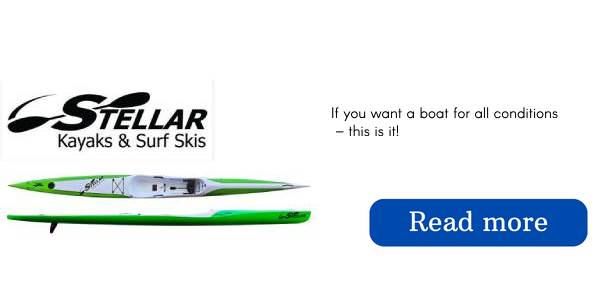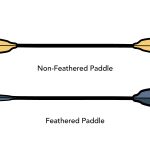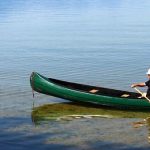The paddle will have the most influence on your success, more so than the kayak. Although it may not appear to be significant, further down the journey after taking a few thousand paddle strokes, you’ll see that it’s actually quite significant.
You should not hastily decide on a kayak paddle.
Here’s a handy guide on how to choose the best kayak paddle for you…
The Importance Of Choosing The Right Kayak Paddle
You’d be astonished at how much the proper or improper kayak paddle can influence your voyage. The significance of the paddle can not be understated, so it should be considered the most vital way of moving through the water.
Choose a paddle that’s not right for you, and you’ll essentially be giving up:
- Control – An unsuitable paddle will usually have an impact on your paddling technique. And that, in turn, means you’ll be giving up some control over your kayak, especially in terms of navigating, maintaining your course, and steering in the desired direction.
- Comfort – Being able to handle the paddle with ease does a lot for your overall comfort. And the more comfortable you are, the longer you’ll stay on the water. Go too short, and you’re up for sore hands and knuckles, with a bit of back pain sprinkled on top. Too long, and you might find it hard to maneuver. Either way, it won’t make for a pleasant outing.
- Usability – It can be the best kayak paddle on the market, but if it doesn’t work for you, you won’t get much out of it performance-wise. You’ll give up efficiency, meaning you’ll have to put in a lot more effort with each stroke, experiencing muscle strain and fatigue on every outing.
Here’s a piece of advice:
If you’re purchasing a paddle at a retail outlet and there is no inquiry into your selection, quickly leave the premises. It seems apparent that they are not attempting to assist you in pinpointing the ideal kayak paddle for you.
Step #1 What Type Of Kayaking Do You Enjoy?
People who kayak for fun will require a different type of paddle than those who commonly run fast-flowing water or take multiple-day trips. Kayaks have varying characteristics which have an effect on their behaviour in the water.
It goes without saying that the type of paddle you use should be suited to the way you kayak or, more accurately, what you plan to use the kayak for.
To begin selecting the perfect kayak paddle, you should decide the type of kayaking you plan to do and what your performance requirements are.
In other words, consider where and how you will be utilizing the paddle.
Step #2 High-Angle Vs. Low-Angle: What Is Your Paddling Style?
Paddles can be used with either a high- or low-angle paddling technique and the size of the kayak paddle will depend on these elements. I would argue that being mindful of this factor is the second most crucial element to take into account when deciding on a kayak paddle.
Here’s a quick overview of two paddling styles:
- High-angle paddling, where the blade enters the water at a more vertical angle, has a close-to-the-kayak path, and packs more power with each stroke, is more aggressive. It calls for a shorter paddle with wider blades.
- Low-angle paddling, where the shaft is more horizontal, and the blades hit the water further from the hull, is less tiring and usually preferred for leisure paddling and long-distance kayaking. Longer, narrower blades and longer paddle shafts are go-to options for easy-going strokes.
If you cannot determine what way of paddling you prefer, or you tend to mix between the two, it is likely that your technique may not be at its best. If that’s the case.
Step #3 Paddle Length: How Tall Are You & How Wide Is Your Kayak?
Once you have decided which style of paddling and purpose you are looking for, you can then find the appropriate size of paddle to suit you.
In regards to selecting a kayak paddle length, one needs to take into account the individual’s particular height, torso length, and the width of the boat. This can be a difficult decision.
Step #4 What Are Your Paddling Goals?
Take some time to ponder what you want to achieve.
What aspirations do you have as a paddler? What are you expecting to gain by improving the kayak paddle?
Do you anticipate increasing your strength in your stroke? Are you hoping to reduce muscle fatigue? Is it a matter of improved control?
Or is it all of the above?
Choosing the correct kayak paddle will drastically increase your performance, but it is smart to think about which area of your performance you hope to make better.
Step #5 What Is Your Budget?
It would be ridiculous to not take budget into consideration when selecting a kayak paddle; it is just as influential a factor when buying a paddle as it is when obtaining a kayak.
Figure out the amount of money you’re willing to part with and make sure your anticipations are in accordance with that financial plan.
Let’s face it; you won’t be able to purchase an expensive Carbon fiber paddle unless you allocate a fair amount of funds for it, as well as you don’t really need it if you’re just starting in kayaking. You can keep the oar that came with your kayak for now; buy a better one if you decide that kayaking will be a permanent pastime.
If you need to stay within a tight budget while still obtaining an adequate kayak paddle, a good option to consider is a hybrid that includes Carbon-reinforced nylon blades.
Paddle Lengths – How to Choose the Right Length for You
There is much debate involving how long a kayak paddle should be, and everyone has a different point of view. For anyone who paddles simply for the purpose of leisure on the weekends at the cottage, the size of the paddle is not of particular importance, but for paddlers who travel long distances for the activity, it is significant to have the right size paddle, or the effects of using the wrong length will begin to show.
Different ways to decide on the right paddle length don’t always give identical results, but the advice is usually close to one another. Normally, the differences are at least 10cm or more when measuring the suggested paddle length.
Height Method
The graph below provides a guideline of the suitable length measurements that correspond to your height. Gather data from paddle producers’ advice, yet the ultimate way to find out what size is most appropriate is to take to the water and check out what length feels correct. This chart does not specify the length that would be suitable for you.
| PADDLER HEIGHT | KAYAK WIDTH 21″ – 28″ | KAYAK WIDTH 29″ – 31″ | KAYAK WIDTH 32″ + |
|---|---|---|---|
| up to 5’6″ | 220 cm | 220 cm – 232 cm | 233 cm – 239 cm |
| 5’7″ – 6’0″ | 220 cm – 232 cm | 233 cm – 240 cm | 240 cm – 250 cm |
| 6’1″ – 6’8″ | 230 cm – 235 cm | 230 cm – 250 cm | 252 cm – 265 cm |
Torso Method
Using your torso height as a guide is a way to figure out the right length of paddle. The height of your torso is the amount from your lap (while sitting on a flat surface) to the end of your nose.
| TORSO MEASUREMENT IN INCHES | LENGTH OF PADDLE IN CM |
|---|---|
| 21 – 23 | 180 -190 |
| 24 – 25 | 185 – 210 |
| 26 – 27 | 190 – 210 |
| 28 – 29 | 200 – 215 |
| 30 – 31 | 210 – 230 |
| 32 – 33 | 225 – 240 |
| 34 – 35 | 230 – 240 |
| 36 – 37 | 230 – 250 |
Finger Curl Method
A simple way of judging the appropriate length for a paddle is to stand next to it with both feet firmly on the ground, having one blade tip in contact with the ground.
Stretch out your arm and take hold of the top of the paddle above your head. Put your fingers so that the tops of them are touching the top of the blade, with your middle knuckles being at the point of the blade.
What’s the Best Kayak Paddle for a Beginner?
The most suitable kayak paddle for someone who is just starting out should be one that is within your budget limits, that is appropriate for the kind of kayaking you plan on doing.
No matter what type of paddling you do, whether it is touring, fishing, whitewater, or recreational, there is a certain paddle design that is most recommended. It does not matter whether you are a rookie or an experienced user; the same paddle is appropriate.
If you invest in a more expensive paddle, you will have a more enjoyable experience and fewer frustrations while learning to paddleboard as a novice.
What is the Best Paddle for Whitewater?
The most resilient and responsive whitewater paddle typically consists of both Carbon Fiber for the blade and shaft. It’s also a one-piece design and is not feathered. Feather-shaped oars provide maximum ease of use for lengthy, placid trips, not for short, exciting, level 5 raging currents!
Feathers on oars can become pliable at their junction with time passing.
Paddles used for whitewater canoeing or kayaking should feature wide blades from top to bottom and a shorter shaft for the best performance. These blades should also have a high-angle design. This allows for improved management of superficial waters and a shorter paddle (which is beneficial in rapids).
What’s the Best Kayak Paddle Material?
Carbon fiber provides the most optimal balance of lightness, durability, power, and longevity when looking for a kayak paddle. From the perspective of a person using a paddle, the only disadvantage to opting for a carbon paddle is the price tag associated with it.
Carbon Fiber paddles do not corrode like aluminum, and they do not have to be re-finished like wood because they do not become worn down. This was mentioned previously. These paddles won’t feel cold in your grip, plus they let you use all your strength in every stroke so that no energy is wasted from the pole or paddle.
Carbon Fiber is the lightest choice available and they have a striking appearance which signals their costliness.
Specialty Kayak Paddles
In addition to the versatility afforded by having both low-angle and high-angle paddles for various kayaks and strokes, specialized paddles designed specifically for activities like fishing or touring provide another excellent option for participation in those activities.
Kayak Fishing Paddle
Kayak fishing oars have distinct qualities separating them from conventional kayak oars.
The length of these kayak paddles is estimated to be approximately 260 cm, making them the longest kayak paddles of any kind. The main cause for this is that fishing kayaks are generally wider than the other types of kayak. Furthermore, sitting in this kayak places the paddler at a slightly higher level than kayakers in other kayaks.
The distance between the paddler and the water increases because of the two distinctions. A paddle that is extended in length makes it significantly simpler to move your boat (specifically with a stroke that has a small angle).
Bending Branches produces its “Angler” series of paddles, featuring the most high-grade materials and designs that are uniquely crafted for fishing applications.
The Pelican paddle has the same specs as a Bending Branches paddle, but it is much more affordable as the Pelican brand is not seen as luxurious as the Bending Branches.
Greenland Touring Paddle
The Greenland touring paddle was built with long-distance open water paddling in mind, and it consequently outperforms conventional paddles for river or shallow water activities.
Greenland paddles have a shaft that is of a smaller length compared to a “regular” paddle, so the hands of the person paddling are positioned closer together.
Greenland paddles have certain benefits that surpass the traditional type of paddles that feature two individual blades located at the end of a long pole or rod.
One of the benefits of utilizing a regular paddle is that when you initiate a power stroke, the newly inserted blade engages the water, providing more resistance to your pull, which can be helpful for preventing stress in the long term.
A Greenland paddle doesn’t have a blade that’s clearly visible at the end of the shaft, so the stroke doesn’t involve a “first heave” of energy, rather, energy is applied more gradually during the middle and end of the stroke.
How to Choose the Right Kayak Paddle – Key Takeaways
Think about the model of the kayak you own, as well as the kind of canoeing you plan to do. Once you ascertain the answer, the potential solutions decrease and the process of making a choice becomes more straightforward.
Attempt to utilize the paddle in the water first before deciding to purchase it as I have found out through experience that even though a paddle may appear to be excellent on its description including various features, it might not feel comfortable in your hands.
Paddle on and blessings to you all my friends!




